OR/18/013 The 'Bunter' 3D generic model
| Quinn, M, Hannis, S, Williams, J, Kirby, G, and McCormac, M. 2018. Multiscale Whole Systems Modelling and Analysis Project — A description of the selection, building and characterisation of a set of 3D generic CO2 storage models. British Geological Survey Open Report, OR/18/013. |
Introduction
This chapter describes the reasoning behind the location, model build method and attribution of the generic Bunter Sandstone Formation geological model. The model is located within a part of the Bunter Sandstone Formation that is bounded by a series of major fault zones and salt walls, roughly coincident with the area studied by Noy et al. (2012)[1] (Figure 14). This area contains the typical domal structures within the post Zechstein succession, seen in other parts of the Southern North Sea (SNS), and in which the Bunter Sandstone formation is thought to possess storage potential; these are currently being assessed for CO2 storage by industry.
The model location was chosen because it contained 'typical structures' and good data availability over the gas fields. Three domes of varying geometries (differing shapes and sizes), are located within the model, two of which host producing gas fields. The model is located on the edge of the aquifer compartment, and is likely to have closed boundaries to the east and south and open boundaries to the rest of the area to the west and north. Figure 14 displays a map showing the regional context. Due to the relative scarcity of gas fields in the Bunter as a whole, combined with its vast potential for saline aquifer storage (Bentham, 2006[2]), for the purposes of this study the gas fields were treated as being brine filled.
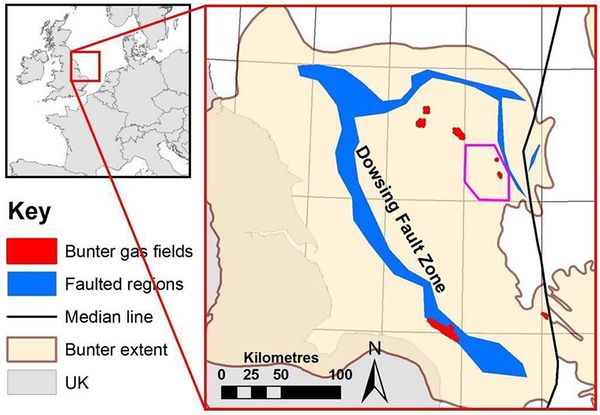
The static model was attributed with the following properties; facies, total porosity (PHIT), net to gross (NTG) and permeability. All properties aside from permeability are based on the interpretation of 25 geophysical logs within the model area, combined with geological knowledge of likely lateral property distributions. Little permeability data exist within the model area (only within the gas leg of the fields) and the geological complexities of permeability and reservoir connectivity are not well documented. Therefore, in keeping with the study being a generic modelling exercise, permeability relationships were derived from regional core data (including saline aquifer intervals and over the full Bunter thickness) and were used to guide the permeability ranges and distribution within the model. Permeability therefore represents the greatest uncertainty likely to affect the dynamic modelling results. For this reason, three different permeability cases were derived based on porosity-permeability relationships from regional core data, and are considered here as low, medium and high cases to be taken forward in the dynamic modelling work by Imperial College. The model provided was based on a single realisation of the stochastically-derived reservoir model, which was itself based upon the upscaling and interpretation of the available model-specific and regional geological data.
Geological background
Brief geological description
The Bunter Sandstone Formation is the offshore equivalent to the Sherwood Sandstone Group onshore UK (Ambrose et al., 2014)[4], and to the Main Buntsandstein Formation in the Dutch Sector of the North Sea (Cameron et al., 1992)[5]. The formation outcrops onshore in Eastern England, and dips towards the offshore area where it extends beneath the Southern North Sea (Figure 15). The offshore extension of interest for CO2 storage is comprised of Triassic aged sheetflood sandstones deposited in an arid to semi-arid environment, with sediments derived mainly from the west–southwest (Cameron et al., 1992[5]). During the Triassic, fluvial systems transected a low relief braidplain via a series of low sinuosity channels, draining towards a playa lake environment to the northeast of the Caister B field ('d' in Figure 3.4 ; Ritchie and Pratsides, 1993[6]).
Muir et al. (1994)[7] suggested that the Bunter Sandstone Formation sandy sediments were deposited on sand-flats by ephemeral streams and sheetflood events, with mudstones deposited during water ponding in flood basins and temporary lakes during times of heavy rainfall. Halite and anhydrite cementation commonly occurs within the formation (Ketter, 1991b[8]), and may be indicative of increased salinity caused by evaporation of floodwaters, although groundwater flow from nearby lakes may also have contributed to increased halite cementation within the sand-flats (Muir et al., 1994[7]).
Structurally, the depth of the formation in the Southern North Sea is highly variable, due to the effects of halokinesis in the underlying Permian evaporites of the Zechstein Supergroup. Halokinesis occurred intermittently throughout the Mesozoic, having begun as early as late Carnian to Norian times during deposition of the Upper parts of the Haisborough Group (Allen et al., 1994[9]), with a major episode occurring in the Early to Mid Eocene and continuing progressively into the Oligocene (Underhill, 2009[10]). Five of the eight producing gas fields in the Bunter Sandstone are four-way dip-closed structures formed by halokinesis.
Faulting, which occurs over many of the structures, is generally related to extensional stresses in the post-Zechstein strata caused by halokinesis, but the potential for CO2 storage is focused on those structures that do not exhibit faults which significantly offset the Bunter Sandstone and its caprock succession. Small-offset faulting is known to affect at least four of the Bunter gas fields over which 3D seismic data is available, cutting the Bunter Sandstone above the field gas water contacts and indicating that faulting where present, does not necessarily provide migration pathways for buoyant fluids from the reservoir (Williams et al., 2013[11]; Williams et al., 2014[12]).
The Haisborough Group provides the top seal to the reservoir (Figure 15) and comprises a thick sequence of predominantly red mudstone and up to three halite-bearing members that, in ascending order, are the Röt, Muschelkalk and Keuper halites. Seedhouse and Racey (1997)[13] show that where present, halite members of the analogous Triassic top seal succession in the East Irish Sea basin act as highly effective caprocks to natural gas, due to their very high capillary entry pressures. The Haisborough Group is overlain by Rhaetic and Jurassic strata consisting predominantly of mudstones and interbedded thin limestones assigned to the Penarth, Lias, West Sole and Humber groups. These deposits have been removed in many places by erosion associated with the Late Cimmerian Unconformity, which cuts down into the Bunter Sandstone Formation (Figure 15). Where this occurs, the mudstone-dominated Cromer Knoll Group provides the top seal to the Bunter Sandstone, as is the case in the Orwell gas field (Underhill et al., 2009[14]). Armitage et al. (2013)[15] suggest that rocks analogous to those of the Haisborough Group should be capable of supporting CO2 column heights of up to 540 m, based on measurements from the Willow Farm borehole, onshore UK.
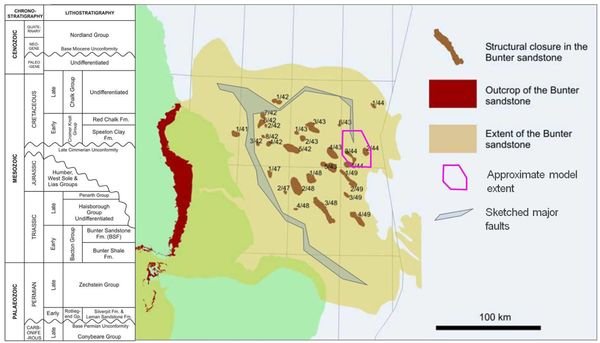
Reasoning behind selection of model area
A generic Bunter model was built for the project with a CO2 storage capacity to store 5 Mt/year for 30 years within several structures.
Selection of a suitable area drew on geological expertise from previous storage capacity studies including Bentham et al., 2006[2] (Figure 15) and Noy et al., 2012[1]. During the UK Energy Technologies Institute’s UK Storage Appraisal Project (ETI UKSAP, Gammer et al., 2011[16]), the Bunter Sandstone Formation was divided into what were thought to be 16 possible regional pressure compartments (known as 'zones'). Structural traps based on top reservoir topography were identified within the zones, known as closures (52 closures in total). The closures all fell within seven of the 16 zones (results can be accessed via CO2Stored, 2013[17]).
Zone 4 (Figure 16) contained the majority of the closures, and contained the most typical periclinal four-way dip- closed structures (generally referred to as ‘domes’) of interest for CO2 storage. The closures in Zone 4 also tended to be less affected by faulting than those that lie in the more southerly zones, which are 'untypical' in that they had dissimilar, irregular geometries, often associated with faulting, inversion tectonics and steep bounding salt walls.
The project Bunter model lies within Zone 4 in this region of 'typical domes' (pink outline in Figure 16). However, detailed data about the Bunter closures from the ETI UKSAP project were unavailable at the model selection stage within Zone 4. Therefore, a short comparison study was carried out to inform the selection of a representative model area. Information on seven closures was examined to compare the relative sizes of domes within ETI Zone 4 (Table 5 and Figure 17). This demonstrates the 'typical' or generic nature of the domes within the chosen model area (depth-coloured polygon, Figure 16).
The model is ~40 km in width with a calculated pore volume within the Bunter Sandstone of ~30 km3 (i.e. meeting the 5 Mt/year for 30 years storage capacity requirement). Table 6 compares the average Bunter thicknesses model area to those across the whole formation, and those within Zone 4. The model consists of three main 'typical' domal structures (with 2 additional smaller subsidiary domes included in Table 5 calculations) and, as previously discussed, two of the three main domes host gas fields, which have very good data availability. The model lies at the edge of Zone 4 and is likely to have closed boundaries to the east and south and open boundaries to the rest of Zone 4 to the west and north. The boundary conditions are therefore something that could be numerically changed to represent 'moving' the generic model around within ETI Zone 4, as the proximity to potentially closed boundaries will affect pressure build-up during injection.
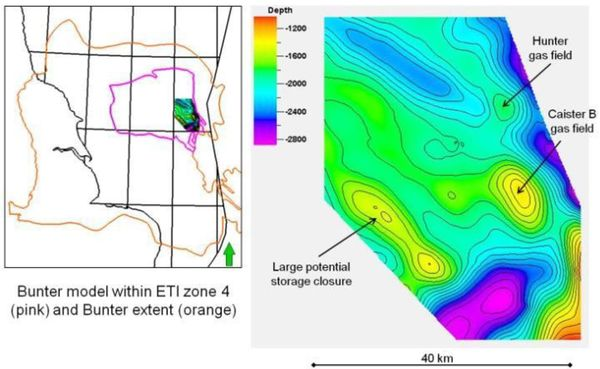
| Gas fields (from literature) | Closures (relinquishment or prospectivity reports) | Closures within Whole Systems project model area (illustrated in Figure 16) | ||||||||||
| Esmond | Forbes | Gordon | CaisterB | 44/15 | 42/19 | 42/15 | 1 Small closure by Hunter | 2 Hunter | 3 Caister B | 4 Small closure by Caister | 5 Long southerly dome | |
| Depth to crest | 1369 | 1719 | 1591 | 1325 | 1475 | 1510 | 980 | 1920 | 1805 | 1325 | 1695 | 1400 |
| Depth to spill | 1494 | 1844 | 1676 | 1737 | 1750 | 1640 | 1075 | 1965 | 1970 | 1737 | 1780 | 1725 |
| Amplitude | 125 | 125 | 85 | 412 | 275 | 130 | 95 | 45 | 165 | 412 | 85 | 325 |
| Length | 5.5 | 8 | 10 | 11 | 10 | 10 | 6.5 | 5 | 7 | 11 | 5 | 22 |
| Width | 4.5 | 5 | 2.5 | 6 | 4 | 4 | 3 | 3 | 5 | 6 | 3 | 6 |
| Area (approx) | 24.75 | 40 | 25 | 66 | 40 | 40 | 19.5 | 15 | 35 | 66 | 15 | 132 |

| Bunter Sandstone | Min | Mean | Max | Source |
| Thickness acro sswhole Formation | 10 m | 230 m | 476 m | CO2STORED |
| Thick ness in ETIZone 4 | 49 m | 199 m | 388 m | CO2STORED |
| Thickness inmodel area | 136 m | 175 m | 335 m | Model statistics |
Sealing caprock
The main sealing caprock above the Bunter is the Haisborough Group, a mixture of mudstones and halites. The thin basal clay of the Haisborough Group is known as the Solling Claystone in the Netherlands sector (it is not delineated as a stratigraphic unit in the UK), where it has a porosity of 2.7% and a permeability of 0.0065 mD (Spain and Conrad, 1997[18]). This is directly overlain by a thicker unit of halite, known as the Rot Halite Member (50–100 m thick, Heinemann et al., 2012[19]). This is assumed to form an effective impermeable barrier. In some parts of the model area, Jurassic sediments overlie the Haisborough (Figure 15). In other parts of the model area, where the Late Cimmerian Unconformity (Base Cretaceous) truncates the sequence, the Bunter may be directly overlain by the Lower Cretaceous Speeton Clay Formation. Although relatively thin compared to the Haisborough Group, this unit is also expected to form a seal to any upward migrating CO2 and have similar properties to the Solling Claystone (its sealing potential is to some degree demonstrated over the Orwell gas field where it forms the primary caprock, Williams et al., 2014[12]). The Bunter Sandstone overlies the Bunter Shale (the lower part of the Bacton Group); this is expected to form a barrier to CO2 flow beneath the Bunter Sandstone reservoir.
Reservoir property relationships
Facies: The Bunter Sandstone is composed predominantly of various types of sheet flood sand complexes deposited in an arid to semi-arid environment. Sediment transport direction is mainly from the west and south west (Ritchie & Pratsides, 1993[6]), the direction of the main sediment supply. Thin interbedded mudstones, most common towards the top of the sequence, were deposited in ephemeral lakes. In general, these become more prolific further east (i.e. further from the sediment source).
Porosity: Generally good. An arithmetic mean (from regional core data) of 19% is quoted in Noy et al. (2012)[1]. Original, primary porosity is related to depositional environment, i.e. grain sorting and roundness. However, the formation has been affected in parts by diagenetic cements. The mechanisms controlling where these cements occur is not well understood, leading to known difficulties in predicting reservoir quality. For example, some areas are affected by halite porosity occlusion (with known associated difficulties in identifying these in well log geophysics), however in other areas there may be evidence for hydrocarbon presence (current or past) having inhibited diagenetic cementing processes. For these reasons the porosity values do not show a relationship either to current depth or palaeo-reconstructed depth (i.e. to pre-salt movement levels). Also, note that where halite porosity occlusion occurs, core data may not accurately reflect the downhole porosity depending on the degree of washing during core preparation.
Permeability: Analysis of regional core-plug data for the Bunter Sandstone shows significant scatter, but an approximate relationship appears to exist between porosity and permeability (See Figure 3b of Noy et al., 2012[1]). Where the vertical permeability (Kv) was measured in addition to the horizontal permeability (Kh) in general the relationship between Kv and Kh is roughly 1 (See Figure 3c of Noy et al., 2012[1]). However again, there is significant scatter, particularly in the region where Kv < Kh. This is thought to represent the reduced vertical permeability of muddier bands acting as vertical permeability barriers within core plugs and present throughout much of the formation. On average the vertical permeability values, given in Table 1 of Noy et al. (2012)[1], are some 30% lower than the equivalent horizontal permeabilities.
Data sources
Top major Formation or Group surfaces from coarse 1 km grids over the model area were provided courtesy of Petroleum Geo-Services (PGS) from their interpreted seismic data. 109 wells with well tops interpreted were available over the model area from background BGS data holdings and from CDA (https://www.ukoilandgasdata.com/). Of these, 25 with suitable geophysical log data were interpreted for this project for internal reservoir correlation and property distribution investigation (Table 7 and Figure 18).
| Wells with interpreted geophysical logs in the model | ||||
| 44/16-2 | 44/21-3 | 44/22-1 | 44/23-4 | 44/23-9 |
| 44/17-1 | 44/21-5 | 44/22-3 | 44/23-5 | 44/23a-10 |
| 44/17-2 | 44/21a-10 | 44/22-7 | 44/23-6 | 44/27-2 |
| 44/21-1 | 44/21a-6 | 44/22b-8 | 44/23-7 | 44/28-1 |
| 44/21-2 | 44/21b-8 | 44/23-3 | 44/23-8 | 44/28-4 |
The interpreted logs were provided to Imperial College for their further analysis. Regional core plug porosity — permeability data were analysed by BGS, sourced from CDA. Only limited core data were available within the model area itself (partial core from three wells from the gas leg of gas fields). Of the core data, only those within the model area were provided to Imperial College.
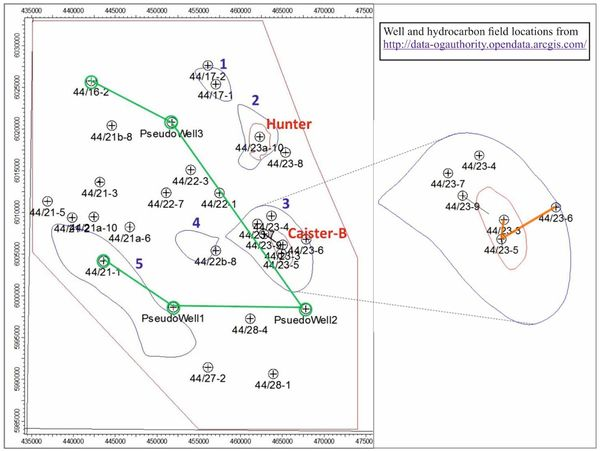
Building the model
Model structure, stratigraphy and internal architecture
The reader can visualize this model in 3D by clicking on this link. The Bunter is on average 175 m thick in the model area (Table 6). The model has been subdivided into seven Bunter Zones, according to the system devised by Ritchie & Pratsides (1993)[6] for their subdivision across the Caister B gas field (Figure 19).
In a small area in the north east of the model, the Late Cimmerian Unconformity cuts down into the top zone of the Bunter. In this area, the caprock seal is therefore the Speeton Clay rather than the Haisborough Group. This is specific to the location of the model in the far south-east of Zone 4 and so is not considered to be important in this 'generic' study to derive KPIs, depending on caprock properties assigned.
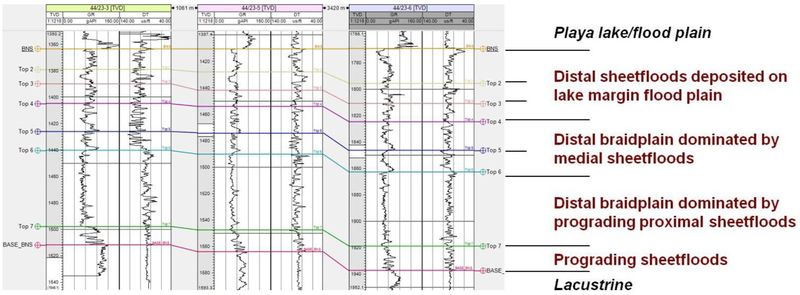
A horizontal grid resolution of 200 m x 200 m was used to incorporate sufficient geological detail. Vertical subdivision in the model was set-up according to Table 8. The minimum cell thickness was set to 2 m to avoid very thin cells. Overburden units were incorporated as being a single cell thick only, reflecting assumed bulk attribution in the dynamic model. Underburden (Bunter Shale) was included using a fractional layering style, with two upper thin cells and one larger one beneath. This was to allow dynamic modelling to incorporate potential pressure relief through the shales beneath the reservoir. The reservoir itself is subdivided into 2 m thick cells to incorporate suitable geological heterogeneity from the upscaled well logs. The top of the Bunter Sandstone is in some places eroded by the Hardegsen and/or Late Cimmerian unconformities. For this reason, the upper part (Zone 1) is incorporated in the model using the layering style 'follow base' to represent potential erosion of its top surface. Lower layers are incorporated as 'follow top' to represent the predominant deposition in channels and sheet floods, where subsequent sand layers onlap onto the layers below.
The model has a total of 7.7 million cells, and of these, 3.2 million are 'active' (meaning they do not pinch-out, and possess a pore volume and permeability). Further upscaling was therefore expected to be required prior to dynamic simulation in Eclipse by Imperial College.
| Model Zone name | Layering style | Number of cells (vertically) | Cell thickness (average) |
| Chalk Group | Proportional | 1 | Variable, 663 m average |
| Cromer Knoll Group | Proportional | 1 | Variable, 53 m average |
| Haisborough group | Proportional | 1 | Variable, 574 m average |
| Zone 1 | Follow base | Variable, maximum 30 | 2 m thick |
| Zone 2 | Follow top | Variable, maximum 13 | 2 m thick |
| Zone 3 | Follow top | Variable, maximum 17 | 2 m thick |
| Zone 4 | Follow top | Variable, maximum 22 | 2 m thick |
| Zone 5 | Follow top | Variable, maximum 14 | 2 m thick |
| Zone 6 | Follow top | Variable, maximum 48 | 2 m thick |
| Zone 7 | Follow top | Variable, maximum 13 | 2 m thick |
| Bunter Shale | Fractions (2,2,30) | 3 | Variable, 124 m average |
Attributing the model
Facies
Due to the lack of core data distributed throughout the model, a pseudo litho-facies scheme was derived based on the volume of clay logs (Vcl) interpreted from the 25 wells (Table 7). Clay volume was interpreted in a similar way to that for the Leman Sandstone (see Volume of shale and net to gross) using the Interactive Petrophysics software and a combination of available raw well data curves, including gamma ray, density, neutron, caliper and density correction curves, where available. Clay volume here was interpreted to be representative of the depositional environment. Thus the Vcl values were subdivided into four categories, as shown in Table 9, with the low Vcl values (0–0.25) representing the sandier facies and the high Vcl values (0.75–1) representing the muddier facies.
The facies categories were upscaled into the 3D geocellular grid where the cells intersected the well path with data, and propagated throughout the model using Sequential Indicator Simulation (SIS), a stochastic technique described by Deutsch and Journel (1992)[20]. Lateral parameters (Table 10) were based on knowledge of lateral facies extents and orientations, for example, the azimuth of 60° was chosen to reflect the known dominant flow direction from SW to NE in the Bunter and continuity (range) distances are representative of those measured at outcrop or depositional analogues. The same lateral variograms were used for each facies category. Vertical parameters were based on data analysis of the upscaled logs (and so were different for each facies and zone), using proportions and distributions for each facies in each zone.
Figure 20 shows a single iteration of the attributed model. The lateral continuity of thin muddier layers can be seen in the upper parts of the reservoir and the basal zone, as observed from correlation between well logs. The basal zone (Zone 7) is known to have a greater mud content and this is also reflected in the attribution.
**The Nugget represents variability at distances smaller than the typical sample spacing, including measurement error.
| Parameter | Value (all facies) |
| Azimuth | 60˚ |
| Major range | 10 000 m |
| Minor range | 5000 m |
| Type | Spherical |
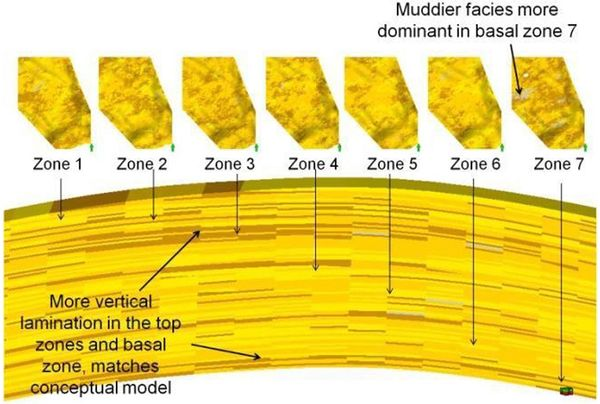
Net to gross
A net to gross property (NTG) is useful when upscaling PETREL models into Eclipse for dynamic simulation, as it is used to calculate effective pore volume (see Volume of shale and net to gross). However here, rather than for the reservoir as a whole, a NTG property for each cell was achieved by upscaling a continuous log calculated using NTG=1-Vcl. This represents the fraction of the cell (gross) that is 'good' (net). Vertical parameters were based on data analysis of the upscaled logs (Table 11), using proportions and distributions of each facies in each zone. Mean NTG of the Bunter as a whole in the model area is 0.62. Figure 21 shows the NTG as property in one iteration of the attribution.
| Parameter | Value (all facies) |
| Vertical range | 8 m |
| Nugget ** | 0.26 |
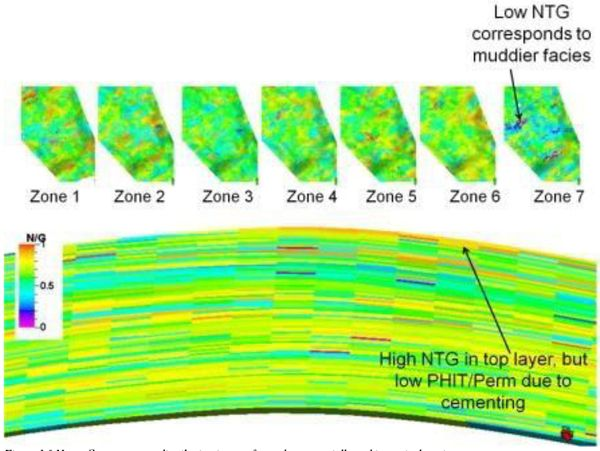
Porosity
Total porosity, PHIT, was interpreted from geophysical logs for the 25 wells with sufficient data available over the model. PHIT was distributed through the model because:
- the core data poro-perm relationship was shown to be related to PHIT rather than the effective porosity (PHIE) (Figure 22);
- effective pore volumes can be calculated in Eclipse on import using the net to gross property.
The 25 interpreted total porosity (PHIT) logs were upscaled and biased to the facies log to ensure the properties were averaging over the appropriate vertical intervals into the cells. Total porosity was distributed through the intervening cells using Sequential Indicator Simulation (SIS), conditioned to the facies property (i.e. the lateral distribution was the same as for the facies property). Vertical parameters were based on data analysis of the upscaled logs (Table 12), using proportions and distributions of each facies in each zone. The mean porosity of the model is 0.18%.

| Parameter | Value (all facies) |
| Vertical range | 7.8 |
| Nugget ** | 0.22 |
Figure 23 shows the porosity distributed throughout the model during one attribution iteration. Note the porosity in the upper layers is much lower due to diagenetic cementation.
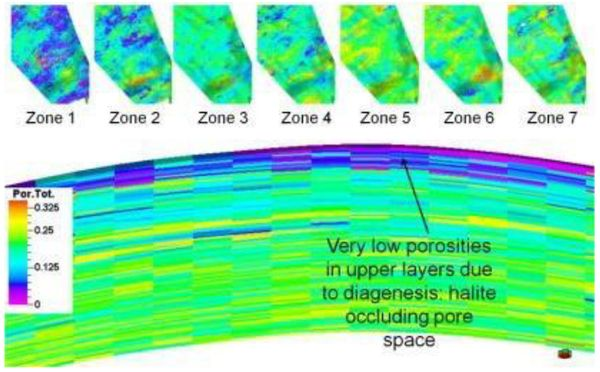
Permeability
Very little core data exists over the model area (partial core and only from the gas leg of the gas fields). Therefore, it was decided to use porosity — permeability relationships derived from regional core data for all wells available in Bunter. The core data porosity values in the model correspond to the interpreted PHIT curves (Figure 22), so permeability was estimated directly from the total porosity model.
The exponential relationships were derived by first, binning (splitting continuous data up into ‘bins’ or intervals it falls in) the permeability values to each 1% porosity interval, and by calculating the P10, P50 and P90 exceedance probability values at each porosity percentage interval. This resulted in a single permeability value at each porosity percentage (for each case), from which exponential curves were calculated (Figure 24, right).
Based on the regional permeability description (see Reservoir property relationships), Kv:Kh ratio in the model is 1. However, this could be varied to give further cases of possible Kv:Kh ratios (see Reservoir property relationships). Note that the regional core data is not available for this project, but see Noy et al. (2012)[1], their Figure 3 for graphical representation. The core data for the Caister B field (Figure 24, left) are provided with the model if additional analysis is required.

Property distribution testing using pseudo wells
Three pseudo wells were inserted to see how well modelled properties match the real data (see Figure 18 for well locations and Figure 25). It can be seen that in general, the properties at the pseudo wells (central 3 well sticks in Figure 25) match fairly well with the real data distribution shown at the two wells at either end of Figure 25, particularly in the upper layers. However, in Zone 6, the shaley sandstone (facies code 2, brown) appears to be over represented and in Zone 7, the very shaley sandstone (facies code 3, grey) appears to under-represented. The vertical distribution of heterogeneity is expected to have a relatively large effect on the upward migration and flow pathway of injected CO2. This could therefore be an additional sensitivity that could be varied during the subsequent simulations (see Area types/sensitivity test for dynamic KPI investigation).
Over/under burden properties
The reservoir is directly overlain by the thin, low permeability Solling Claystone, on average 4 m thick. Above this is the Röt Halite (50–100 m, assumed impermeable), with further mudstone and halite successions of the Haisborough Group above that forming a barrier to upward CO2 migration in excess of 200 m thick. Directly beneath the reservoir is the Bunter Shale Formation. This is assumed to be low permeability mudstone with similar properties to the Solling Claystone, measured in the Dutch Sector by Spain & Conrad (1997)[18]. Table 13 shows the overburden and underburden properties in the model. These are bulk-assigned, based on values taken from the literature (sources in far right column of table).
| Geological unit | Facies | NT G | Porosity (fraction) | Permeability (mD) | Source |
| Chalk Group | Chalk | 1 | 0.36 | 0.01 | Megson and Hardman, 2001[21] |
| Cromer Knoll Group | Shale | 0 | 0.027 | 0.0065 | Spain & Conrad,1997[18], value for Solling Claystone |
| Haisborough Group | Mudstone & Halite | 0 | 0 | 0 | Halite |
| Bunter Shale Formation | Shale | 0 | 0.027 | 0.0065 | Spain & Conrad, 1997[18], value for Solling Claystone |

Model boundary conditions based on reservoir geology
Vertical boundary conditions: If the attributed overburden/underburden itself is not included in the model (see Over/under burden properties), it is suggested that the upper bounding surface of the reservoir be treated as impermeable (to represent the halites). If possible, the lower surface should have low permeability too, for example, a cell with a pore volume multiplier appropriate to represent the Bunter Shale.

Lateral boundary conditions: The model lies within ETI Zone 4 (Figure 16 and Figure 26) and the boundaries to the east and south are assumed to be closed due to either the presence of faults and salt walls or the absence of the Bunter formation itself (due to erosion). The model boundaries to the north and west are assumed to be open to the remainder of the pore volume with ETI Zone 4. The total volume of model is 263 km3 and the pore volume of the model is 30 km3. Assuming similar volume ratios for the whole of ETI Zone 4, which has a total volume of 1890 km3, the estimated total pore volume of Zone 4 would be 216 km3.
Area types/sensitivity tests for dynamic KPI investigation
Area types were not considered suitable for the Bunter sandstone in the same way as those implemented for the other models (see The 'Rotliegend' generic model #Definition of area types and The 'Cenozoic' 3D generic model). This was mainly because there was insufficient knowledge and definition of the property distribution trends within the large saline aquifer. For example, preliminary and background knowledge studies showed that there was no obvious porosity — depth (current or palaeo-topographic) relationship for the Bunter, as found for the Permian Leman Sandstone (see The 'Rotliegend' generic model). Diagenetic changes to porosity and permeability are documented in the Bunter, for example, halite infilling pore-space, but these are poorly constrained geographically. The degree of permeability of the formation is important for CO2 injection and for the Bunter sandstone, the distribution of diagenetic related permeability inhibition or enhancement is poorly understood. Therefore, a different approach was implemented, involving proposed sensitivity studies based around the key geological uncertainties e.g. Table 6, rather than fixed parameter ranges for particular areas (the area types method).
The main geological uncertainties considered for CO2 injection into the Bunter Sandstone — and that are therefore thought to be appropriate to be investigated include:
- Boundary conditions (discussed in Model boundary conditions based on reservoir geology);
- Permeability;
- Heterogeneity — The UK Bunter Sandstone is near its sediment source supply (in the west/south west, see Reservoir property relationships) (i.e. proximal), and consists of relatively massive sands that become progressively more shaley toward the Dutch Sector. (The model is located in a more distal position (i.e. further to the east). The degree of reservoir heterogeneity (in particular the lateral continuity of shaley layers in the upper part of the Bunter) and their effects on vertical permeability are therefore also thought to be an important controlling factor for CO2 injection and storage. Thus, for example, a Bunter Storage reservoir in a more proximal position could perhaps be expected to be more homogeneous, potentially with a higher porosity and vertical permeability (due to fewer shale laminations inhibiting vertical flow) and with different boundary conditions reflecting its more westerly position.
References
- ↑ 1.0 1.1 1.2 1.3 1.4 1.5 1.6 NOY, D J, HOLLOWAY, S, CHADWICK, R A, WILLIAMS, J D O, HANNIS, S D, and LAHANN, R W. 2012. Modelling large-scale carbon dioxide injection into the Bunter Sandstone in the UK Southern North Sea. International Journal of Greenhouse Gas Control, Vol. 9, pp. 220–233.
- ↑ 2.0 2.1 2.2 BENTHAM, M. 2006. An assessment of carbon sequestration potential in the UK – Southern North Sea case study. Tyndall Centre for Climate Change Research, working paper 85. Available from: https://oldsite.tyndall.ac.uk/working_papers/working_papers.shtml?keys=Bentham
- ↑ HANNIS, S D, BRICKER, S, GOATER, A, HOLLOWAY, S, RUSHTON, J, WILLIAMS, G, WILLIAMS, J. 2013. Cross-international boundary effects of CO2 injection. Energy Procedia, 37, pp. 4927–4936.
- ↑ AMBROSE, K, HOUGH, E, SMITH, N J P, WARRINGTON, G. 2014 Lithostratigraphy of the Sherwood Sandstone Group of England, Wales and south-west Scotland. Nottingham, UK, British Geological Survey, 50pp. (RR/14/001)
- ↑ 5.0 5.1 CAMERON, T D J, CROSBY, A, BALSON, P S, JEFFERY, D H, LOTT, GK, BULAT, J, and HARRISON, D J. 1992. The Geology of the Southern North Sea. United Kingdom Offshore Regional Report, British Geological Survey and HMSO, London.
- ↑ 6.0 6.1 6.2 6.3 RITCHIE, J S and PRATSIDES, P. 1993. The Caister Fields, Block 44/23a, UK North Sea. In: Parker, J R. (ed.) Petroleum Geology of Northwest Europe: Proceedings of the Fourth Conference, Geological Society, London, 759–769.
- ↑ 7.0 7.1 MUIR, R O, THIRWALL, M, and WALSH, J N. 1994. The Upper Buntsandstein in Well 49/6A-4: A sedimentological and geochemical investigation of the origin of the cements. Royal Holloway, University of London Report.
- ↑ KETTER, F J. 1991b. The Esmond, Forbes and Gordon Fields, Blocks, 43/8a, 43/13a, 43/15a, 43/20a, UK North Sea. In: Abbotts, I L. (ed.) United Kingdom Oil and Gas Fields, 25 Years Commemorative Volume, Geological Society Memoir, 14, 425–432.
- ↑ ALLEN, M R, GRIFFITHS, P A., CRAIG, J, FITCHES, W R, and WHITTINGTON, R J. 1994. Halokinetic initiation of Mesozoic tectonics in the Southern North Sea: a regional model. Geological Magazine, Vol. 131, pp. 559–561.
- ↑ UNDERHILL, J R. 2009. Role of intrusion-induced salt mobility in controlling the formation of the enigmatic ‘Silverpit Crater’, UK Southern North Sea. Petroleum Geoscience. Vol. 15, pp. 197–216.
- ↑ WILLIAMS, J D O, JIN, M, BENTHAM, M, PICKUP, G E, HANNIS, S D, and MACKAY, E J. 2013. Modelling carbon dioxide storage within closed structures in the UK Bunter Sandstone Formation. International Journal of Greenhouse Gas Control 18, pp. 33–50.
- ↑ 12.0 12.1 WILLIAMS, J D O, HOLLOWAY S, and WILLIAMS G A. 2014. Pressure constraints on the CO2 storage capacity of the saline waterbearing parts of the Bunter Sandstone Formation in the UK Southern North Sea. Petroleum Geoscience 20 (2), pp 155–167. The Geological Society of London 2014. doi 10.1144/petgeo2013-019
- ↑ SEEDHOUSE, J K, and RACEY, A. 1997. Sealing Capacity of the Mercia Mudstone Group in the East Irish Sea Basin: Implications for Petroleum Exploration. Journal of Petroleum Geology 20, pp. 261–286.
- ↑ UNDERHILL, J R, LYKAKIS, N, and SHAFIQUE, S. 2009. Turning exploration risk into a carbon storage opportunity in the UK Southern North Sea. Petroleum Geoscience, Vol. 15, pp. 291–304.
- ↑ ARMITAGE, P J, WORDEN, R H, FAULKNER, D H, APLIN, A C, BUTCHER, A R, and ESPIE, A A. 2013. Mercia Mudstone Formation caprock to carbon capture and storage sites: petrology and petrophysical characteristics. Journal of the Geological Society, London, Vol. 170, pp. 119–132.
- ↑ GAMMER, D, GREEN, A, HOLLOWAY, S, and SMITH, G. 2011. The Energy Technologies Institute’s UK CO2 Storage Appraisal Project (UKSAP). SPE 148426, presented at the SPE Offshore Europe Oil and Gas Conference and Exhibition, Aberdeen, UK, 6–8 September, 2011.
- ↑ CO2STORED. 2013. CO2Stored CO2 Storage Evaluation Database Version 2 Release 1. Available at: https://www.co2stored.co.uk/, Accessed: September 2014. © The Energy Technologies Institute LLP.
- ↑ 18.0 18.1 18.2 18.3 SPAIN, J D, and CONRAD, C P. 1997. Quantitative analysis of top-seal capacity: offshore Netherlands, Southern North Sea. Geologie en Mijnbouw 76, pp. 217–226.
- ↑ HEINEMANN, N, WILKINSON, M, PICKUP, G E, HASZELDINE, R S, and CUTLER, N A. 2012. CO2 storage in the offshore UK Bunter Sandstone Formation. International Journal of Greenhouse Gas Control; 6:210-219.
- ↑ DEUTSCH, C V, and A G. JOURNEL. 1992. Geostatistical software library and user's guide. Oxford University Press, New York.340 pp.
- ↑ MEGSON, J, and HARDMAN, R. 2001. Exploration for and development of hydrocarbons in the Chalk of the North Sea: a low permeability system. Petroleum Geoscience, Vol. 7, pp. 3–12.
